Exploring the Loose Diamond Market Dynamics
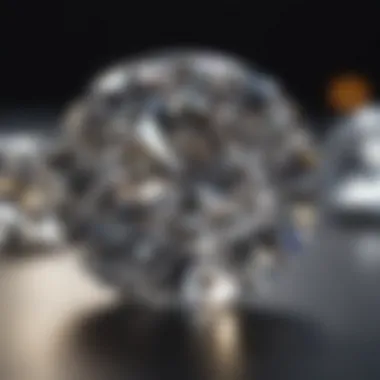
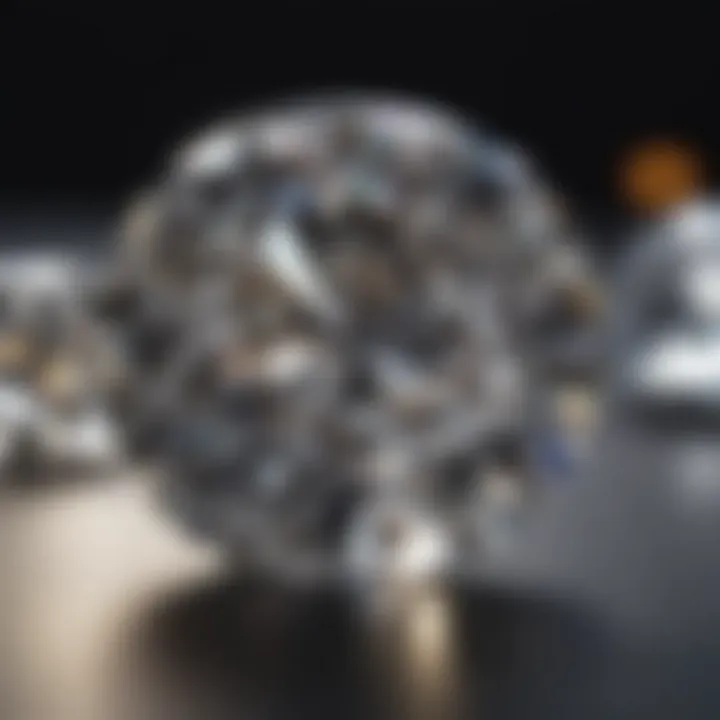
Intro
The allure of diamonds has captivated people for centuries. When we think of these precious stones, we often envision sparkling engagement rings or standout jewelry pieces. However, the world of loose diamonds offers a different perspective—one that dives deep into the complexities of their market, investment potential, and ethical implications. Loose diamonds are not merely exquisite accessories; they represent significant financial assets.
As we peel back the layers on this glittering subject, we will explore the evolving purchasing practices influenced by market trends that shape the experience of both collectors and casual buyers alike. It’s a vibrant conversation that extends beyond dazzling appearances, reflecting deep-rooted values and concerns as well.
Gemstone Overview
Definition and Characteristics
Loose diamonds, by definition, are diamonds that aren’t set in any jewelry. They exist independently, allowing collectors and buyers to appreciate their inherent beauty and individuality. A diamond in its loose form can demonstrate brilliant brilliance and fire—qualities that captivate both the eye and mind. They come in a plethora of shapes—round, princess, emerald, and more—each influencing the diamond’s overall appeal and price.
Classification of Gemstones
To fully comprehend the market for loose diamonds, one must understand their classification within the broader gemstone context. While diamonds are often thought of in isolation, they are part of the gemstone family, which includes colored stones, pearls, and corals, among others.
- Precious Stones: These usually include diamonds, rubies, sapphires, and emeralds. Their rarity and exceptional quality contribute to their high value.
- Semi-Precious Stones: This category encompasses a variety of gemstones like amethyst, topaz, and garnet. While they hold beauty, they’re more abundant and generally less expensive than precious variants.
Diamonds occupy a unique title among gemstones due to their remarkable durability and status. Their classification is based on factors like rarity and desirability. Recently, however, market shifts have expanded how people perceive the value of non-diamond stones, adding layers to investment recommendations.
Properties of Gemstones
Physical Properties
The allure of diamonds doesn't stop at their visual impact. Physically, they are one of the hardest substances known to humankind, rated a 10 on the Mohs scale of hardness. This property not only makes them ideal for everyday wear but also symbolizes strength and resilience.
Chemical Properties
Chemically speaking, diamonds are composed of carbon atoms arranged in a crystal lattice structure, providing insights into their formation in nature. This singular composition is responsible for their unique optical properties, including brilliance and dispersion. Understanding these chemical foundations gives buyers a greater appreciation for what they possess.
"A loose diamond is not merely a stone; it is a timeless artifact that intertwines beauty with story and value."
By diving into the intricacies of diamond types and their properties, enthusiasts can make informed choices when investing in or purchasing these coveted gems.
The market for loose diamonds is ever-evolving, and understanding how these factors interplay is vital for anyone engaging with this fascinating realm.
The Intricacies of Loose Diamonds
Loose diamonds represent more than just a gemstone; they are an intersection of art, science, and investment opportunities. Understanding their complexities is crucial for anyone interested in the diamond market. By delving into the features that make these gems distinct, one can make informed decisions whether for personal use or investment purposes.
Definition and Characteristics
A loose diamond is essentially a diamond that is not set into any jewelry. It stands alone, often showcased in its full brilliance and beauty. The defining characteristics of loose diamonds include their cut, color, clarity, and carat weight—known collectively as the Four Cs. These attributes serve not only as a guide for quality assessment but also have significant implications when it comes to pricing and desirability.
Cut refers to how well a diamond has been shaped and faceted. It greatly influences the diamond's sparkle and overall visual appeal. A well-cut diamond—think of a perfectly shaped round brilliant—captures and reflects light in a way that lesser cuts cannot. Meanwhile, color ranges from colorless to light yellow or brown, impacting both value and beauty.
Clarity assesses the presence of internal or external flaws, known as inclusions and blemishes, respectively. A diamond that appears flawless—free of visible imperfections—commands a higher price. Carat weight measures the size of the diamond, though it’s essential to note that two diamonds of the same carat weight can still differ significantly in appearance based on the other Cs.
Understanding these characteristics allows potential buyers to appreciate not just the physical aspects of loose diamonds but also the market dynamics surrounding them.
Market Trends in Loose Diamonds
Currently, the market for loose diamonds is evolving, influenced by various factors such as consumer preferences, global economic conditions, and emerging technologies. In recent years, a noticeable trend has been the increasing demand for ethically sourced and sustainable diamonds. Consumers are becoming more conscious of the origins of their purchases, leading to a rise in conflict-free diamonds and the growing reputation of lab-grown alternatives.
Moreover, the digital marketplace is reshaping how loose diamonds are bought and sold. Online platforms offer consumers a broader selection and price transparency that was hard to come by in brick-and-mortar stores. This shift has led to greater accessibility, enabling a wider range of customers, from casual buyers to seasoned collectors, to engage with the diamond market. Additionally, savvy investors are becoming aware of the investment potential in loose diamonds, viewing them as a hedge against inflation and a tangible asset.
To summarize, the intricacies of loose diamonds encompass a variety of elements from defining characteristics to evolving market trends. Being well-versed in these aspects can empower buyers—not just to snag a great deal but to make choices that align with their values and expectations in this multifaceted domain.
The Four Cs of Diamonds
Diamonds are often seen as mere stones, yet their value transcends their physicality. When navigating the market for loose diamonds, understanding the Four Cs—Cut, Color, Clarity, and Carat Weight—is crucial. Each of these factors not only defines the beauty of a diamond but also plays a pivotal role in their pricing and desirability. For anyone looking to purchase a diamond, grasping these elements can mean the difference between buying a gem that's merely pretty and one that's truly exceptional.
Cut
The cut of a diamond can dramatically influence its brilliance and overall appearance. It’s not just about shape; the cut quality reflects how well the diamond interacts with light. An expertly cut diamond will sparkle and shine, captivating the eye. Conversely, a poorly cut diamond can appear dull, regardless of its size or clarity.
When assessing cut, three principal factors come into play: proportions, symmetry, and polish. Proportions refer to how the stone has been faceted; symmetry addresses how uniform the cut is, impacting visual harmony; and polish details the smoothness of the diamond's surface. While the round brilliant cut is the most popular, fancy shapes such as emerald and cushion cuts have their own appeal.
A well-executed cut can enhance a diamond's fire, which is the colorful light it emits when viewed from different angles.
Color
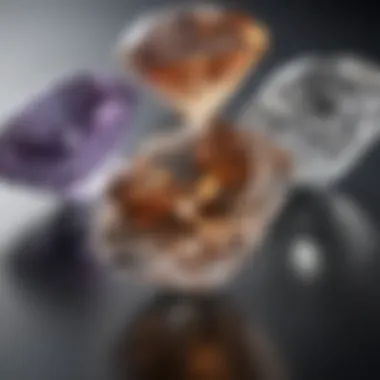
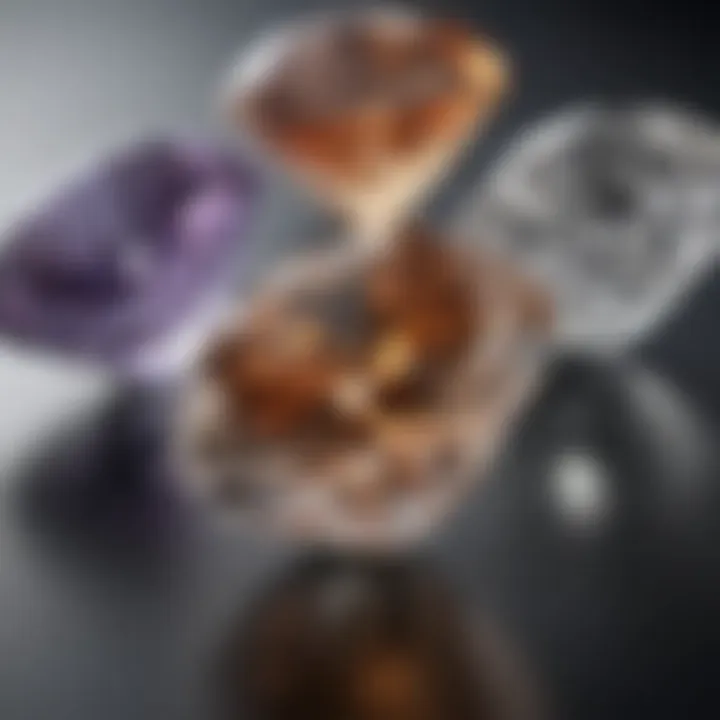
Color in diamonds can be somewhat counterintuitive, particularly since most people assume a diamond must be colorless to be valuable. However, the grading scale for diamond color ranges from D (colorless) to Z (light yellow), meaning a higher clarity doesn’t always equate to higher desirability. Some buyers prefer faintly colored diamonds, often referred to as "chocolate" or "champagne," which evoke an emotional or aesthetic appeal that can’t be measured purely by color grading systems.
Understanding hue versus saturation is important; a deep, rich color can be as sought after as a colorless diamond. Observing how light interacts with color also deepens appreciation.
Clarity
Clarity assesses the presence of internal or external imperfections—often called inclusions and blemishes, respectively. The Gemological Institute of America (GIA) categorizes clarity using a scale that ranges from Flawless (no inclusions visible under 10x magnification) to Included (inclusions visible to the naked eye).
It’s essential to remember that a diamond’s clarity doesn’t solely dictate its overall visual appeal. Some styles and settings can cleverly disguise inclusions. For example, a diamond with minor blemishes can still shine brightly once set in a beautiful ring, making it an alluring choice for buyers prioritizing budget without sacrificing style.
Carat Weight
Carat weight speaks directly to size, and larger diamonds are generally more valuable and rare. However, it’s vital not to equate a higher carat with a better diamond without considering the other three Cs. Buyers often find themselves at a crossroads: should they opt for a larger diamond that is slightly lower in cut or clarity, or a smaller stone that truly dazzles? Ultimately, the choice depends on personal preference and the intended purpose of the diamond.
In addition, it is worth noting that the price per carat increases with size, and the relationship isn't linear. A two-carat diamond will not be just double the price of a one-carat stone—it's often significantly more expensive due to rarity and demand.
Understanding these Four Cs equips consumers with the necessary knowledge to make informed and confident decisions in the loose diamond market. Taking each factor into account will not only lead you to a stunning gemstone but also ensure you appreciate the intricate balance that defines true diamond quality.
The Significance of Certification
Certification plays a crucial role in the market for loose diamonds, serving as a guarantee of quality and authenticity. For buyers, understanding certification is virtually non-negotiable in today’s market. A credible certification can alleviate doubts about a diamond's origins and characteristics, ensuring that one's investment is sound.
The certification process assesses the diamond through various established criteria, which includes aspects such as cut, clarity, color, and carat weight, collectively known as the Four Cs. Furthermore, reputable certification bodies offer insights beyond these measures by providing additional data about the diamond's origins, treatments, and any historical significance attached to it. Without a certification, a buyer might as well be flipping a coin, uncertain of whether the diamond is genuine or even worth its asking price.
"When purchasing loose diamonds, think of certification as both a shield and a sword. It protects buyers from deception while empowering them to make informed choices."
In summary, the significance of certification cannot be understated; it builds trust between the seller and buyer, thereby enhancing the overall market's integrity. Buyers often gravitate towards diamonds that possess certifications from recognized institutions, as it is a reflection of quality and dependable value.
GIA and Other Renowned Institutions
The Gemological Institute of America (GIA) stands out in the world of diamond certification. Established in 1931, it has earned acclaim for its stringent grading systems and thorough evaluations. The GIA not only examines diamonds but also educates about them, providing a wealth of knowledge for consumers and professionals alike. Their grading reports are respected worldwide, often serving as the gold standard in the industry.
Apart from GIA, other noteworthy institutions include the International Gemological Institute (IGI), the American Gem Society (AGS), and the European Gemological Laboratory (EGL). Each of these organizations brings its own standards, certification processes, and reputations, allowing buyers varied options when it comes to verification:
- International Gemological Institute (IGI): Focused on consumer education and awareness, IGI offers comprehensive grading reports for both diamonds and other gemstones.
- American Gem Society (AGS): Known for its strict grading criteria, AGS provides not just reports but also emphasizes ethical practices in the diamond trade.
- European Gemological Laboratory (EGL): Operating in multiple countries, EGL’s certificates cater to a broad audience and offer insights into various aspects of gemology.
Importance of Authenticity
Authenticity is at the heart of diamond certification—a diamond that claims to be of a specific quality must indeed possess those qualifying traits. Certifying authorities undertake painstaking analyses and meticulous inspections to confirm that every diamond meets or exceeds the stated criteria. A diamond without certification creates uncertainties, making it difficult for a buyer to accurately assess its value and quality.
Moreover, authenticated diamonds tend to hold their value over time more effectively than their uncertified counterparts. When diamonds are sold with verifiable documentation, it not only bolsters their resale potential but also reassures future buyers that they are making a sound investment.
Investing in a certified diamond is akin to buying a car with a verified history—no one wants to discover hidden flaws or issues that were not disclosed from the outset. Thus, the importance of authenticity cannot be overstated. It enables buyers to navigate the diamond market with confidence, secure in the knowledge that their purchases represent true value.
Shopping for Loose Diamonds
When it comes to loose diamonds, knowing where and how to shop matters a great deal. This section delves into the essential elements of shopping for loose diamonds, providing valuable insights for enthusiasts and collectors alike. It's crucial to have a grasp of not only where to find these precious stones but also how to evaluate their quality and negotiate their prices effectively.
Where to Buy
Choosing the right place to buy a loose diamond can feel like looking for a needle in a haystack. You’ve got options galore, but not all options are created equal. Here are some popular avenues worth considering:
- Retail Jewelers: A traditional choice, but it’s crucial to ensure they offer certified stones.
- Online Boutiques: Websites like Blue Nile and James Allen provide a vast selection with the convenience of shopping from home. Here, you can filter by the four Cs, simplifying the search.
- Auction Houses: For the adventurous, houses like Sotheby’s or Christie’s can offer unique pieces but beware of the competition and potential price spikes.
- Wholesale Dealers: For those willing to do a bit more legwork, wholesalers may offer lower prices. Just ensure to check the legitimacy of their certifications.
Overall, the venue you choose will affect not just the experience but also the price and quality of the diamond.
Evaluating Quality
Realizing that all diamonds are not created equal has a lot to do with understanding their quality. When assessing a loose diamond, the following points can guide you:
- Examine the Certificate: Always request a grading certificate from a reputable organization like the GIA or AGS. This document spells out the diamond's specifics, ensuring it matches your criteria.
- Check for Light Performance: How a diamond interacts with light is a crucial quality indicator. A diamond should exhibit brilliance and fire; if it looks dull under light, best to steer clear.
- Seek Professional Insight: If you're unsure, don’t hesitate to seek help from a gemologist. Their trained eye can catch imperfections that might elude the average shopper.
- Inspect for Inclusions: Use a jeweler's loupe – a small, magnifying tool – to examine the diamond closely for any internal flaws. This step can significantly affect not just beauty but price too.
By taking the time to evaluate quality thoroughly, you position yourself better in making an informed purchase.
Negotiating Prices
Even the best deals on loose diamonds can sometimes be maneuvered further down. Here are some strategies to consider:
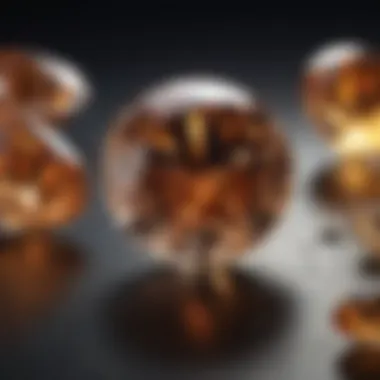
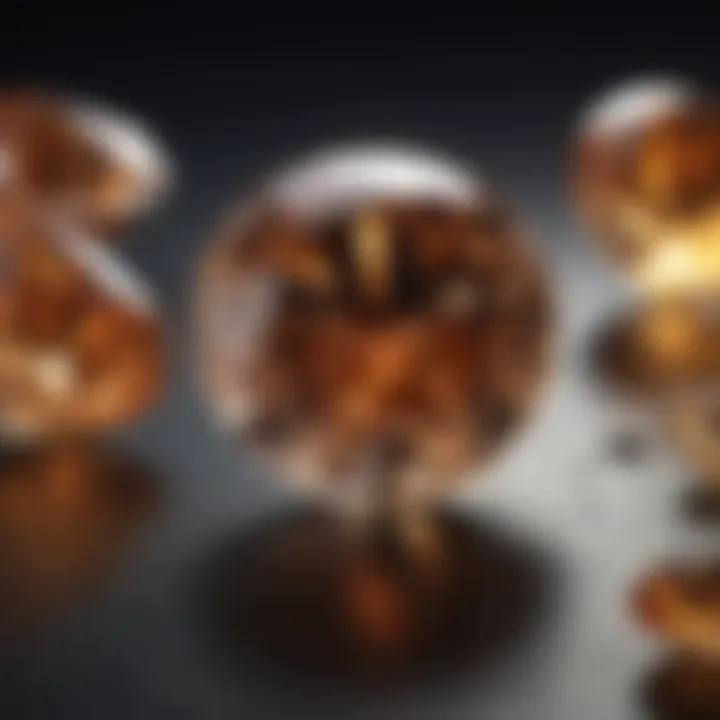
- Know the Market: Familiarize yourself with current diamond prices. Websites, like Gemval, can help determine reasonable price ranges.
- Be Prepared to Walk Away: Leverage the power of detachment. If negotiations don't sway in your favor, expressing your willingness to leave could encourage the seller to work with you.
- Bundle Purchases: Sometimes, buying more than one piece can net you a better overall deal. If you're in the market for, say, earrings to match your loose diamond, inquire about discounts on the total purchase.
- Timing: Certain times in the year see jewelry sales, particularly around Valentine’s Day or Christmas. Trying to strike a deal during these times could bless you with unexpected savings.
Ultimately, negotiating can feel daunting, but with a little knowledge and preparation, you can secure a loose diamond without feeling like you've overpaid.
Ethical Considerations in Diamond Sales
The realm of loose diamonds has always been entwined with ethical concerns that extend beyond the gleam of their surface. In today's market, consumers are more informed and conscious about the implications of their purchases. This section takes a closer look at the ethical considerations in diamond sales, focusing specifically on conflict-free diamonds and sustainable practices. Understanding these elements not only nurtures informed buying decisions but also promotes a healthier industry for future generations.
Conflict-Free Diamonds
When individuals consider buying a diamond, one of the most pressing moral concerns that come into play is whether the stone is conflict-free. Conflict diamonds, often called blood diamonds, are stones mined in war zones and sold to finance armed conflict. The societal and humanitarian crises associated with such diamonds raise important questions for conscientious buyers.
A conflict-free label assures consumers that their purchase does not contribute to violence or human rights violations. It serves as a critical marker of integrity in the marketplace. Many reputable retailers now provide certifications or guarantees assuring that their diamonds comply with the Kimberley Process, which aims to track and regulate diamond imports to eradicate the trade in conflict diamonds. Through due diligence, buyers can choose to support ethical sourcing—a choice that reflects both concerns for moral implications and respect for human life.
Additionally, as awareness has grown regarding the impact of their purchases, some consumers may consciously opt for companies that provide transparency in their supply chain. This includes traceability, allowing buyers to know where their diamond originates and under what circumstances it was mined. Such choices resonate with a growing segment of the market that prioritizes ethics as an integral part of their purchasing power.
“Buying a conflict-free diamond is not just a transaction; it’s a statement of values and awareness.”
Sustainable Practices
Beyond ensuring diamonds are conflict-free, sustainable practices gain momentum as another essential consideration in the diamond industry. Sustainability encapsulates a commitment to environmental stewardship and responsible sourcing, which resonate with modern consumers looking to minimize their ecological footprint.
Adopting sustainable practices in diamond mining often involves environmentally-friendly extraction methods that reduce habitat destruction and conserve natural resources. For instance, some companies are investing in methods that recycle materials and promote restoration after mining activities. By reducing the environmental impact of diamond extraction, the industry can foster a more sustainable future.
Moreover, the rise of lab-grown diamonds presents an intriguing alternative for those concerned with sustainability. These stones, created in controlled environments, often use fewer resources and energy than conventional diamond mining. Lab-grown diamonds also avoid many of the ethical quandaries associated with traditional mining, appealing to a demographic that values both quality and responsibility.
Given the advances in technology, lab-grown diamonds can be virtually indistinguishable from mined diamonds. This might lead to broader acceptance, influencing consumers to shift toward more sustainable choices.
As awareness around sustainability continues to evolve, buyers are encouraged to prioritize brands that engage in ethical mining practices and exhibit a commitment to environmental protection.
The Historical Context of Diamonds
When examining the market for loose diamonds, it's crucial to recognize the historical backdrop against which these precious stones have been valued and appreciated. Diamonds, transcending mere beauty, have woven themselves into the fabric of human civilization, manifesting not just in commerce but also in art, legend, and society. Understanding this context allows consumers, investors, and enthusiasts to appreciate diamonds beyond their aesthetic allure.
Legends and Folklore
For centuries, diamonds have sparked legends that spin tales of power and mystique. In ancient India, diamonds were believed to possess protective powers. Tales circulated about how they could protect warriors in battle; a belief often rooted in the idea that they could absorb negative energies. Moving westward, Greco-Roman cultures added a layer of divinity to diamonds, associating them with the gods. Diamonds were seen as tears from the gods or splinters of stars fallen to earth, further elevating their status.
This storytelling continues to influence modern perceptions. For instance, tales of the infamous Hope Diamond, purportedly cursed, fascinate many and keep the myth alive, drawing curiosity towards its history and heritage. Such legends often shape consumer psychology, suggesting that ancient beliefs may continue to influence buying decisions today.
Diamonds in Cultural Artifacts
Studying diamonds through the lens of cultural artifacts provides insight into their significance throughout history. In several royal artifacts, diamonds adorned thrones and crowns, serving as symbols of sovereignty and wealth. The famous Koh-i-Noor diamond, borne by many rulers, has a storied history, encapsulating the tumultuous journey of empires and dynasties.
Moreover, beyond royalty, diamonds appear in various rituals and artistic expressions. In some cultures, they symbolize eternal love and commitment. For example, the tradition of diamond engagement rings, popularized in the 20th century, reflects both cultural norms and marketing strategies, melding history with contemporary consumer values.
In summary, recognizing the historical context of diamonds is not merely an academic exercise; it's an exploration of their timeless allure. This knowledge enriches the understanding of market trends and consumer behavior, bridging the gap between the past and present. As demand for loose diamonds evolves, appreciating their historical significance can guide potential buyers, ensuring they invest not just in stones, but in storied treasures that resonate throughout millennia.
Investing in Loose Diamonds
Investing in loose diamonds has gained traction among both seasoned collectors and new investors looking to diversify their portfolios. Unlike traditional investments like stocks, which can be volatile, diamonds offer a unique blend of aesthetic appeal and intrinsic value. There’s an air of exclusivity about owning loose diamonds, especially when they hold quality characteristics that align with current market demands.
Market Analysis for Investors
When considering market analysis, investors must delve into several layers of the diamond industry. Key aspects include:
- Supply and Demand Dynamics: The scarcity of high-quality diamonds can drive prices up, making it essential to monitor how supply chains and economic factors impact market availability.
- Market Trends: Observing trends such as increasing demand for ethically sourced diamonds or the rise of lab-grown stones is vital. Understanding these trends can help investors identify lucrative opportunities in the market.
- Economic Climate: Global economic fluctuations can significantly affect luxury goods. Investors often benefit from recognizing economic indicators that suggest an upturn or downturn in diamond pricing.
Regardless of how you slice it, knowing when to buy and when to sell is crucial. Diamonds are not typically liquid assets; they can require time to find the right buyer, especially if dealing with unique characteristics.
Resale Value Considerations
When contemplating the resale value of loose diamonds, several factors come into play, notably:
- Quality Assessment: The Four Cs—cut, color, clarity, and carat weight—continue to hold sway. High-quality diamonds are generally easier to sell.
- Certification Importance: Diamonds certified by esteemed organizations like the GIA can command a higher resale price. The presence of a well-respected credential reassures buyers about the diamond’s authenticity and value.
- Market Timing: Much like with any investment, timing can make or break the deal. Economic indicators, cultural trends, and even seasonal demands can affect how quickly and profitably diamonds are sold.
In summary, investing in loose diamonds is not just a trend; it requires thoughtful analysis and a keen understanding of both the market and individual diamond quality. Investors who do their homework may find themselves with a tangible, beautiful investment that can yield satisfying returns over time.
"Diamonds may be forever, but their market value can be as fickle as the wind—stay informed, stay prepared."
By combining comprehensive market analysis and astute consideration of resale factors, investors can navigate the diamond landscape with confidence. It opens the door to both passion and profit, amplifying the allure of these beautiful gemstones.
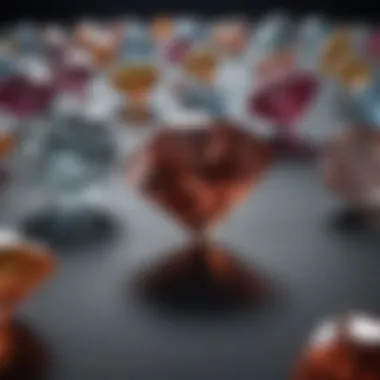

The Role of Technology in the Diamond Industry
The diamond industry has seen remarkable changes over the past decades, largely driven by advancements in technology. As consumer preferences shift, the incorporation of innovative methods has reshaped how diamonds are marketed, produced, and sold. Technology plays a pivotal role in enhancing the overall experience for buyers while addressing longstanding challenges like traceability, ethics, and pricing dynamics. In understanding loose diamonds, recognizing the technological context becomes essential.
Lab-Grown Diamonds
Lab-grown diamonds have revolutionized the market. These diamonds, created in controlled environments under conditions that mimic natural processes, often boast identical physical and chemical properties to their mined counterparts.
With growing awareness about ethical sourcing, many consumers now opt for lab-grown diamonds. They not only represent a more sustainable choice but also typically come at a lower price point.
- Environmental considerations: Lab-grown diamonds require less land and natural resources compared to traditional mining, appealing to eco-conscious consumers.
- Affordability: Buyers can get larger stones for similar prices, which appeals to both engagement and fashion conscious markets.
- Quality assurance: Advancements in technology ensure that lab-grown diamonds also come with high clarity and brilliance standards.
Despite these advantages, some may remain skeptical about their value, often viewing them as inferior. However, education and transparency about these gems can lead to shifts in perception. As lab-grown diamonds gain traction, they prompt a reevaluation of what authenticity means in the diamond world.
Blockchain and Traceability
One pressing concern in the diamond industry is the traceability of stones. Consumers increasingly demand assurance that their diamonds are conflict-free and ethically sourced. Blockchain technology has emerged as a viable solution to address these concerns.
Utilization of blockchain allows for a transparent record of a diamond's journey from mine to market. Each transaction and ownership transfer can be logged, providing an immutable timeline that assures buyers of ethical practices.
- Enhanced credibility: This traceability reassures customers that their purchase supports ethical mining practices.
- Fighting fraud: Blockchain prevents the circulation of fake diamonds, as each legitimate stone has a digital footprint that proves its authenticity.
- Consumer empowerment: Shoppers can make informed decisions, knowing the history of the diamonds they are considering. This empowerment is crucial in a landscape where knowledge builds confidence.
Moreover, by promoting transparency, blockchain technology plays a crucial role in restoring trust in a market that has occasionally struggled with its ethics. The combination of lab-grown diamonds and blockchain illustrates a significant evolution, aligning technological advancements with consumer values.
"The modern diamond buyer seeks more than just a gem; they desire a narrative of integrity and transparency."
Understanding Diamond Pricing
Understanding the pricing of loose diamonds is crucial not only for enthusiasts and collectors but also for those contemplating an investment. The diamond market is complex, and its prices fluctuate based on various factors, enabling buyers and sellers to navigate the landscape effectively. Pricing is not just about the raw cost; it’s about understanding value, demand, and market conditions.
Firstly, potential buyers benefit significantly from grasping diamond pricing dynamics. When you walk into a jeweler’s shop, familiarizing yourself with how prices are determined can bolster your confidence. It enables you to spot a good deal versus an inflated price. Moreover, understanding pricing helps in recognizing trends that could affect future value. For instance, is there a growing demand for ethically sourced diamonds? This knowledge positions consumers better for making informed decisions.
Additionally, by understanding the intricacies of diamond pricing, buyers can adjust their expectations according to market variations. If prices are on the high side, it might not be the right moment to purchase. Adapting to these shifts can save potential buyers significant sums while ensuring they don’t miss out on the emotional allure that a diamond purchase intrinsically holds.
Factors Influencing Price
Several key elements dictate the pricing of diamonds. These include:
- Quality Attributes: The characteristics defined by the Four Cs—Cut, Color, Clarity, and Carat weight—are fundamental. Each 'C' plays a distinctive role in dictating diamond prices. A well-cut diamond is likely to fetch a higher price despite other factors.
- Market Demand and Supply: Like any commodity, the balance between the demand for and supply of diamonds weighs heavily on pricing. In times of economic prosperity, you may find prices climbing higher as more people invest in luxury items.
- Brand Reputation: Diamonds from well-known brands often carry a premium. Consumers trust established names for quality, yet might be missing out on equally good diamonds without the brand label.
- Ethical Considerations: As consumers become increasingly aware of the impact of their purchases, the demand for conflict-free and ethically sourced diamonds could drive pricing in new directions. Buyers might be willing to pay more for transparency and integrity in sourcing, which can motivate sellers to adjust their pricing frameworks accordingly.
- Technological Advances: Innovations in diamond production, including lab-grown diamonds, also influence prices. These stones can be a bit cheaper, reshaping the market landscape. Lab-grown diamonds offer a valid alternative, often at a lower price than their natural counterparts, yet they retain their charm.
Understanding these factors empowers buyers to make informed decisions, leading to a better understanding of the market.
Comparison to Other Gemstones
When discussing pricing, it’s valuable to compare diamonds to other gemstones. While diamonds hold a certain prestigious allure, various factors differentiate their pricing.
- Rarity: Diamonds, particularly high-quality ones, are rarer than many gemstones like quartz or amethyst, which are more abundantly found in nature. The rarity often results in a significant price gap.
- Cultural Significance: In many cultures, diamonds symbolize commitment, luxury, and status, leading to higher demands and, consequently, prices. Other gemstones, while pretty, may not command the same emotional draw.
- Durability: Diamonds rank high on the Mohs scale of hardness. Their resilience makes them ideal for everyday wear, particularly in engagement rings. Other gemstones might be less durable, which can influence their demand.
- Price Elasticity: Some gemstones can experience rapid price fluctuations based on fashion trends. If sapphires or emeralds were all the rage last season, prices could rise dramatically, only to drop just as quickly when trends shift.
“A wise buyer doesn’t just look at the diamond; they also look at the whole picture—from origin to price to personal significance.”
With this knowledge, consumers can navigate the diamond market with a sense of confidence, balancing emotional significance with astute investment strategy.
Consumer Psychology and Loose Diamonds
Consumer psychology plays a pivotal role in the market for loose diamonds, serving as the bridge that connects buyers not only with exquisite gems but also with the emotional narratives that diamonds embody. Understanding this dimension is essential for both sellers and buyers in the diamond trade because decisions surrounding such a significant purchase often intertwine with personal values, cultural significance and even social status.
Perceived Value
Perceived value in the context of loose diamonds is often tied intricately to the concepts of rarity and quality. When consumers look at a diamond, they don’t simply assess its physical attributes; their understanding of the gem's value is woven into the fabric of marketing, media portrayals, and social influences. Diamond campaigns historically project an image of luxury and permanence. The famous catchphrase "A diamond is forever" exemplifies how diamonds are sold as symbols of commitment and timelessness.
Factors influencing perceived value can be broken down into several key areas:
- Brand Reputation: High-end brands like Tiffany & Co. or De Beers have cultivated a legacy that boosts perceived value simply through association.
- Certification: Diamonds graded by respected institutions such as the GIA instill confidence in buyers, ensuring they feel justified in their investment.
- Market Trends: The rise of specific diamond cuts or colors can affect perceived value, often leading to increased demand for styles that are currently in vogue.
Fascinatingly, buyers can be swayed by emotional triggers rather than just logical reasoning. Consumers might find a particular diamond especially appealing because of its unique narrative or connection to personal milestones. Such instincts shape a buyer's willingness to pay, even if the diamond may not objectively outrank others in quality terms.
Emotional Significance
Loose diamonds often carry emotional significance that extends far beyond their physical properties. For many, a diamond represents love, commitment, or celebration, steeped in tradition and mixed with personal experiences. For instance, in many cultures, diamond engagement rings are more than mere adornments; they symbolize the cornerstone of a lifelong bond. The emotional impact is profound.
In evaluating the emotional significance, several elements emerge:
- Milestones: Birthdays, anniversaries, or other significant life events are often marked with diamond purchases, creating lasting memories tied to the stone.
- Social Status: Possessing certain diamonds can elevate one’s social standing, as people perceive gems as reflections of wealth and success.
- Cultural Values: Different cultures assign varying meanings to diamonds, making the same stone hold different values based on its context.
As a result, buyers may find themselves emotionally invested in their purchase, prioritizing aesthetic and sentimental value over cost. This leads to a deeper connection with the gem, as the buyer envisions their life unfolding around it, attaching memories and significance that will outlive the material aspect of the diamond itself.
Emotional connections can often outweigh logical considerations in the diamond-buying process, leading customers to spend more than initially planned based on personal meaning and cultural context.
For gemstone enthusiasts, collectors, and jewelry designers, understanding these aspects of consumer psychology can serve as a powerful tool. It allows them to craft narratives around loose diamonds that resonate on deeper levels, bridging the gap between mere aesthetics and meaningful experiences.



